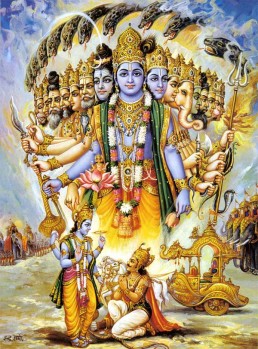Swami Chinmayananda
Swami Chinmayananda Commentary
Continuing his description of the Cosmic-Form, the Pandava Prince gives more and more details of what he comprehends in that incomprehensible Divine extravaganza. He sees therein the Crown, the Club, and the Discus. These are the insignia which Lord Vishnu is said to carry, in all mythological descriptions.
Hindu gods are represented as having certain divine symbols, and they all have their own respective special significances — of Kingship and Lordliness over the world of finite things and happenings. He alone is the Lord who is a Master-of-circumstances and a Ruler-of-impulses. A slave to life and its enchantments is a weakling, on whose head a crown rests only temporarily like the gilted-cardboard-crown of an actor playing on a stage. No authority or effectiveness in life is possible unless the man-in-power has self-control and self-mastery. No man can live a happy and mighty life unless he has conquered his passions and crowned himself with kingship over himself. He is Vishnu and He alone then deserves the crown!
The four-armed Vishnu carries in his hands the Conch, the Discus, the Club, and the Lotus. This is extremely symbolical. In India the Lotus represents “peace and joy, auspiciousness and happiness.” The Conch blows and calls man to duty; and if there be a generation of men who listen not to the Higher-call in themselves, restlessness, war, pestilence, famine, storms, and chaotic social and communal disturbances visit them — the Club descends to hammer the generation to shape and discipline. Even after this punishment, if there be a generation so totally dissipated that it cannot improve, then comes the Discus — the sharp-toothed wheel, ever revolving, the Whirling of Time (Kaala-chakra) to annihilate the irredeemable generation.
When we find these in Arjuna’s description as part of the Universal Form, it becomes evident that the same Truth is the Substratum, not only of the lowest of low worms, but even of the Divine Trinity. The Eternal Truth is one and the same, everywhere, at all times; only Its manifestations are varied, and the degree of Divinity sparkling from each differs according to the grossness or subtlety of the equipment through which the same Infinite Reality expresses Itself.
AS A MASS OF RADIANCE SHINING EVERYWHERE, ALL ROUND GLOWING LIKE THE BLAZING SUN AND FIRE, HARD TO GAZE ON — One of the most expressive lines in this description, this brings home to us the glory of Pure Awareness. This is not ‘light’ in the physical sense of the term; but all the same we have to use the word, borrowed from ordinary language, though it is applied here with a special significance. Consciousness is the ‘Light’ in which we so clearly ‘SEE’ our own thoughts and emotions. It is the same light which, beaming out through the eyes, throws ‘light’ upon the world and illumines for us the FORMS AND SHAPES. The same Consciousness, beaming out through the ears, with its special ‘light,’ illumines SOUND, and so on. Naturally, therefore, the Universal-Form of Krishna, representing in Himself the Infinite Awareness, had to be described, in the faltering language of Arjuna, as a mass of resplendent light, blinding all faculties of perception, feeling and understanding.
INCOMPREHENSIBLE (Aprameya) — So far, though Arjuna described, as best as he could, the Form, and the feelings It had engendered in him, there is a streak of despair running in these stanzas. Arjuna feels that he has not captured the theme fully in the web of his language. Language expresses that which is perceived, or felt, or understood. Here is a form which Arjuna experiences. He beholds. He feels. And he comprehends it in himself. Yet, strangely enough, here is an experience that volatilises and eludes all attempts at being bottled in language! He seems to be not satisfied by the objective description which he gave in the language of his eyes, ears, etc., and he feels equally unhappy with the language of his emotion, as felt by his mind.
True to himself, the wonder-struck mortal is trying to sing the glory of what he lives, in the language of his intellect. But even here he can only cry in despair, “OH LORD THOU ART EVER INCOMPREHENSIBLE.” Though the universal Form is painted here by the author, in the language of an “objective experience,” he makes us understand that the Truth is the SUBJECT and not an object of even the intellect. The Self is the KNOWER, THE FEELER, the PERCEIVER; It is not the perceived, the felt, or the known.
FROM THIS VISION OF THE POWER OF YOGA, I INFER:
Adi Sankara Commentary
Pasyami, I see; tvam, You; as kiritinam, wearing a diadem-kirita is a kind of decoration for the head; one having it is kiriti; gadinam, wielding a mace; and also cakrinam, holding a disc; tejorasim, a mass of brilliance; sarvatah diptimantam, glowing all around; durniriksyam, difficult to look at; samantat, from all sides, at every point; as though dipta-analarka-dyutim, possessed of the radiance (dyuti) of the blazing (dipta) fire (anala) and sun (arka); and aprameyam, immeasurable, i.e. beyond limitation. ‘For this reason also, i.e., by seeing Your power of Yoga, I infer’ that-
The Bhagavad Gita with the commentary of Sri Sankaracharya – Translated by Alladi Mahadeva Sastry
Holy Geeta – Commentary by Swami Chinmayananda
The Bhagavad Gita by Eknath Easwaran – Best selling translation of the Bhagavad Gita
The Bhagavad Gita – Translation and Commentary by Swami Sivananda
Bhagavad Gita – Translation and Commentary by Bhaktivedanta Swami Prabupadha
Srimad Bhagavad Gita Chapter 11 – Verse 17 – 11.17 kiritinam gadinam – All Bhagavad Gita (Geeta) Verses in Sanskrit, English, Transliteration, Word Meaning, Translation, Audio, Shankara Bhashya, Adi Sankaracharya Commentary and Links to Videos by Swami Chinmayananda and others – 11-17

